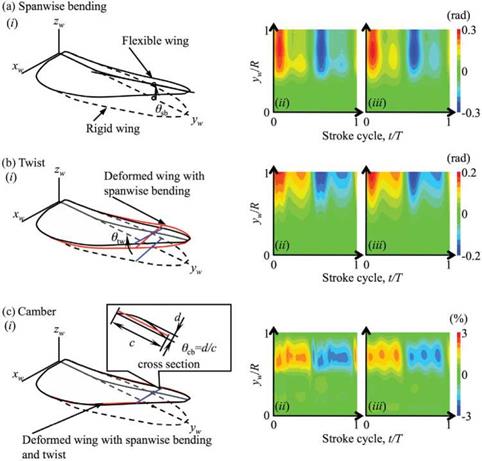Aerodynamic Performance of Flexible Wings
How do these deformations affect the force generation? Time courses of vertical and horizontal force coefficients and aerodynamic force vectors generated by flexible and rigid wings are plotted in Figure 4.55c and d. Although both flexible and rigid wings show a plateau in the vertical aerodynamic force production at early downstroke, the flexible wing obviously creates more force than the rigid wing, and the force vectors contribute more to the vertical force components (Fig. 4.55c, d). Instantaneous

streamlines and pressure contours on the wing surfaces are illustrated in Figure 4.55e during an interval where four instants are marked as A, B, C, and D (Fig. 4.55e). At early downstroke when the wing proceeds to late pronation and undergoes a pitch-down rotation, the LEV and the TEV grow in size and in strength, stretching from the wing base toward the wingtip; the TEV subsequently detaches from the wing, forming a starting vortex but connecting to the LEV and the TiV at the wingtip at A (Fig. 4.55e). Subsequently, the TiV of the rigid wing becomes unstable at C, gradually separating and shedding from the wing surface, which correspondingly results in a shrink pattern of low-pressure contours at the wingtip. In contrast, the LEV and the TiV on the flexible wing seem to be more stable than those of the rigid wing, with an enlarged low-pressure region at B and C (Fig. 4.55e). When the TiV
|
Figure 4.56. (i): Definition of the simulated (a) spanwise bending angle, (b) twist angle, and (c) camber in the flexible wing. (ii) Time courses and spanwise distribution of the three kinds of deformation of a flexible wing and (iii) their interpolated deformation. From Nakata and Liu [523]. |
breaks down and separates from the wing, the LEV still keeps growing with a strong low-pressure region at D (Fig. 4.55e) until the vertical aerodynamic forces generated by both flexible and rigid wings become almost even immediately after the wing turns to decelerate. However, it is interesting to find that, at late downstroke, the flexible wing eventually reaches a higher force peak other than the rigid wing (Fig. 4.55c). When the wing approaches early supination, the aerodynamic force decreases owing to the breakdown or shedding of the LEV and the translational deceleration. Here, the flexible wing can also create larger forces than the rigid wing.












